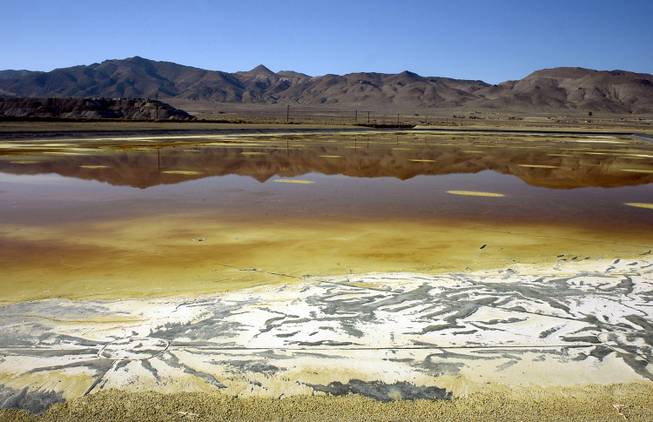
Debra Reid / AP
In this Nov. 30, 2004, file photo, an evaporation pond holds contaminated fluid and sediment at the former Anaconda copper mine near Yerington. Fifteen years after U.S. regulators started assessing the damage and health risks at a contaminated copper mine in Nevada, the Environmental Protection Agency wants to add the abandoned site to its Superfund National Priority List.
Friday, Dec. 25, 2015 | 2 a.m.
RENO — Fifteen years after U.S. regulators started assessing damage and health risks at an abandoned Nevada copper mine, the Environmental Protection Agency is moving to designate the contaminated land a Superfund site, a step the state could still oppose.
Rural neighbors of the World War II-era mine that has leaked toxic chemicals for decades won a $19.5 million settlement in 2013 from companies they accused of covering up the contamination to drinking water wells near Yerington, about 65 miles southeast of Reno.
The EPA sent a letter to Gov. Brian Sandoval this week announcing its intention to place the mine on the list of the nation's most polluted sites to "mitigate exposures that are a substantial threat to the public health or welfare or the environment."
"If we do not receive a written response from the state by Jan. 29, we will assume that Nevada is in agreement with EPA and will proceed with proposing the site for addition to the NPL," Jared Blumenfeld, the agency's regional administrator in San Francisco, wrote in a Dec. 22 letter obtained by The Associated Press. NPL is the acronym for the Superfund's National Priority List.
State officials said they needed to review the letter and determine their next steps.
"We're not going to worry about turf," said Leo Drozdoff, director of the Nevada Department of Conservation and Natural Resources. "What we want is the best and quickest remedy for the site."
Nevada has opposed past EPA proposals to list the site, fearing a stigma that might affect property values and any precedent that could be set by federal intervention in the mining-friendly state, the world's sixth-biggest producer of gold.
Nevada regulators estimated earlier this year that it would cost $30.4 million to address only what the EPA considers the most immediate health and safety concerns, and the state has been unsuccessful in obtaining financial assistance from those responsible for the damage.
Under the Superfund listing, the EPA would cover 90 percent of the costs.
"Without an identifiable private source of funding, the only mechanism to make federal funding available is to add the site to the NPL," Blumenfeld said.
It comes after residents filed a class-action lawsuit in 2011 accusing Atlantic Richfield Co. and parent company BP America Inc. of "intentionally and negligently" concealing the extent of uranium, arsenic and other pollutants leaking into their drinking water wells from the mine.
The mine covers 6 square miles of land owned partly by the U.S. Bureau of Land Management. Atlantic Richfield acquired the property in 1977 from Anaconda Copper, which built the mine in 1941.
Atlantic Richfield has paid for other work on the site, BP spokesman Jason Ryan said.
Previous owners left behind 90 million gallons of acidic solution that continues to threaten the groundwater, Blumenfeld said. That's equivalent to the amount of liquid it would take to cover about 80 football fields, 10 feet deep.
In 2008, a U.S. Labor Department review panel upheld a whistleblower claim by ex-mine cleanup supervisor Earle Dixon who said the BLM illegally fired him for speaking out about the risks in defiance of local politicians.
Peggy Pauly, a Yerington minister's wife, helped organize efforts to demand additional cleanup and filed the lawsuit, joined by about 700 past and present neighbors.
Steven German, a New York-based attorney who represented the residents, called her "the real hero in all of this."
"This is an important next step in getting this massive old mine cleaned up," he said Wednesday of the listing. "It is going to cost a fortune."
Anaconda, the former owner, produced 1.7 billion pounds of copper from 1952 to 1978 at the mine in the Mason Valley, an irrigated agricultural oasis in the otherwise largely barren high desert.
The EPA determined that the uranium was produced as a byproduct of processing the copper and that the radioactive waste was initially dumped into dirt-bottomed ponds that leaked into the groundwater.
Federal studies showed 79 percent of the wells tested north of the mine had dangerous levels of uranium, arsenic or both that made the water unsafe to drink, including one a half-mile away with levels more than 10 times the legal drinking water standard.
At the mine itself, wells tested as high as 100 times the standard. Although the health effects of specific levels are not well-understood, long-term exposure to high levels of uranium in drinking water may cause cancer and damage kidneys, the EPA said.

Join the Discussion:
Check this out for a full explanation of our conversion to the LiveFyre commenting system and instructions on how to sign up for an account.
Full comments policy